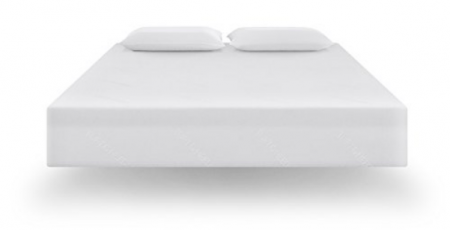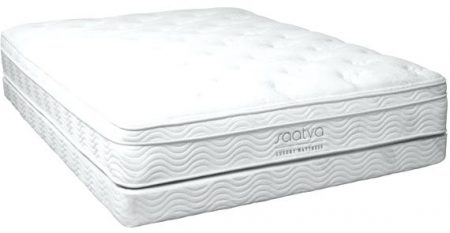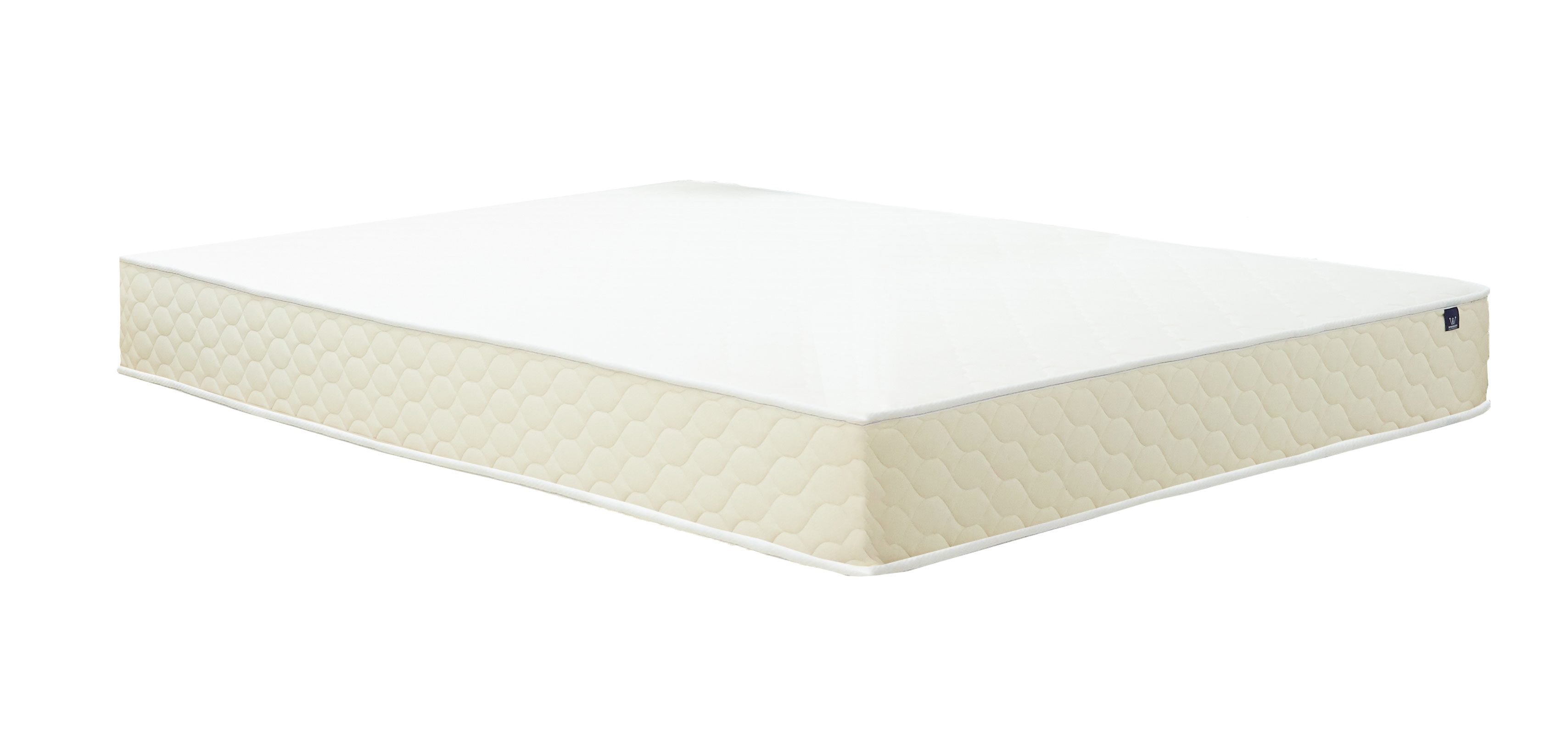Durability
The average mattress will perform for six to eight years of continuous use. The key word here is “continuous,” since your guest bed probably won’t be used as frequently as your own mattress.
Longevity is often tied to price-point, so we recommend weighing your needs before investing in a long-lasting – and potentially expensive – mattress. If you frequently host overnight guests and expect the mattress to be of constant use, then buying a more durable mattress will be in your best interest. If your visitors are more sporadic, then durability shouldn’t be a major concern.
Regardless of how often you host people, you can extend the lifespan of your mattress by rotating it head to foot every three to six months. Also be sure to use a sturdy bed frame, and consider buying a mattress protector if you foresee any young children using the guest mattress.
Temperature Neutrality
Some people run hot in bed regardless of the outside temperature. A mattress constructed with materials that absorb and trap body heat can compound discomfort for these individuals, leading to sweaty and potentially sleepless nights.
Mattress materials that promote breathability and airflow are more comfortable for hot sleepers. These materials include ventilated foam or latex comfort layers, coil support cores, and covers made of natural fibers like cotton.
Investing in a bed made with these materials can help ensure a cool, comfortable night’s rest for your guests – especially if you live in a hot or humid place, or primarily host visitors during warmer times of the year.
Motion Isolation
Changing sleep positions or getting in and out of bed can produce motion that transfers across the surface. On a responsive mattress, this motion can be quite significant and disruptive for other people sharing that bed. A mattress that excels at motion isolation will absorb movement on one side of the bed and reduce – if not outright eliminate – transfer.
A guest bed that provides good motion isolation is a worthwhile investment if you plan to host couples. This will be less of a concern if you’re buying a smaller mattress for single visitors.
Price and Value
A new mattress can cost anywhere from a couple hundred dollars to several thousand. Factors that impact price include materials, size, special features, and the brand.
Unless you’re preparing for a steady stream of overnight visitors, an expensive mattress will probably be overkill. At the same time, choosing a less durable mattress with a low sticker price might mean you’ll need a replacement in as few as two or three years.
We recommend something in the middle: a high-value mattress that holds up well over time but won’t drain your bank account. Our top picks illustrate a few examples of mattresses that are both inexpensive and well-constructed.
Sleep Trial
Since most online mattresses can’t be tested in-person prior to purchasing, these brands offer trial periods that allow customers to sleep on the mattress for a certain length of time before deciding whether to keep it, return it, or exchange it for a different model. Most of these sleep trials span at least 90 nights, but some last a year or longer.
A lengthy sleep trial allows multiple guests to try the mattress and give you feedback on its strengths and weaknesses. This way you’ll be able to send back the mattress and receive a refund if the model you initially choose proves unpopular.
What Type of Mattress Makes the Best Guest Bed?
The “best mattress” is an entirely subjective label, and opinions about your guest bed will probably vary from visitor to visitor. However, you should still familiarize yourself with the characteristics, strengths, and weaknesses of each mattress type before making your purchase.
An all-foam mattress features a comfort layer of memory foam or adaptive polyfoam, followed by transitional and support layers of denser foam.
Our testing shows all-foam mattresses are best for:
- Couples. All-foam mattresses respond slowly to the body and absorb movement, so these models generally perform the best when it comes to motion isolation. Most foam mattresses are also completely silent, and won’t squeak or creak when your partner gets in and out of bed.
- Side sleepers. People who sleep on their sides usually need more cushioning in order to improve their alignment and alleviate pressure points in sensitive areas along the spine, such as the shoulders and hips. Foam mattresses generally reduce pressure better than other mattress types.
- Those who enjoy close conforming. Due to their all-foam designs, these mattresses offer more contouring than all-latex or coil models. People who enjoy the feeling of “sleeping in” – as opposed to “sleeping on” – a mattress should find these beds comfortable.
- Value seekers. The average foam mattress costs between $800 and $1,200 in a queen size, making them one of the most affordable mattress types.
A latex mattress features a comfort layer of latex that conforms gently to the body, followed by support layers of denser latex or polyfoam that provide extra reinforcement.
Our testing shows latex mattresses are best for:
- People who enjoy a combination of contouring and responsiveness. Latex conforms to the body a bit, but not as much as adaptive foam, and the material is naturally bouncy. This creates a balanced feeling of both “sleeping in” and “sleeping on” the mattress.
- Hot sleepers. Latex typically retains less heat than foam, and many latex mattresses feature ventilated layers that promote airflow near the surface. As a result, these beds sleep cool compared to all-foam models.
- Those who want to invest in a durable mattress. Latex resists deep impressions and indentations better than foam, often resulting in a longer-than-average lifespan. A typical latex mattress will perform for at least seven to eight years.
- Shoppers with larger budgets. The average latex mattress costs between $1,500 and $2,200, making them one of the more expensive mattress types. They are a good long-term investment, but may be impractical for guest rooms if you have a limited budget.
A traditional innerspring mattress usually features thin comfort and transitional layers made of foam, followed by a thick support core of steel coils.
Our testing shows innerspring mattresses are best for:
- People who prefer responsive sleep surfaces. The combination of thin foam layers near the surface and a robust coil system in the support core typically produces a very bouncy surface for innersprings. Contouring is minimal, and more motion transfer occurs when sleepers change positions or get in and out of bed.
- Hot sleepers. Innersprings generally excel at temperature neutrality because the coils promote steady air circulation throughout the interior, which helps the mattress stay cool.
- Those who struggle getting in and out of bed. For most innersprings, the coils reinforce the edges and prevent deep sinkage that occurs when you get on and off the mattress. This can be helpful for people with mobility issues or sleepers who weigh more than 230 pounds.
- Value seekers. With an average price-point of $800 to $1,100 in a queen size, innersprings are the least expensive mattress type.
A hybrid is a type of innerspring constructed with thick comfort layers of memory foam or latex, followed by a support core of individually pocketed coils.
Our testing shows hybrid mattresses are best for:
- Sleepers who prefer a mix of contouring and support. Hybrids have deep comfort layers that provide good conforming and pressure relief compared to the thin foam layers of innersprings, while the pocketed coils offer more reinforcement than the support cores of all-foam or latex beds. For many people, this balanced construction is the “best of both worlds.”
- Hot sleepers. Though they may sleep warmer than innersprings, most hybrids perform well for temperature neutrality thanks to steady airflow through their coil layers. Latex hybrids sleep particularly cool since latex retains less heat than foam.
- Couples. Most hybrids provide decent motion isolation and won’t make too much noise, allowing couples to sleep soundly without disruptions, but their coils also generate enough responsiveness for sex.
An airbed is constructed with air chambers in the support core that can be inflated or deflated to change the bed’s firmness level. Comfort layers for airbeds vary – some have thick memory foam or latex layers, while others feature thin foam layers instead.
Our testing shows airbed mattresses are best for:
- People whose firmness preferences vary on a nightly basis. Airbeds are designed for easy adjustability, either with manual or remote controls. These mattresses are a good option for people who want a firmer, more supportive feel one night and a softer, contouring feel the next.
- Couples with differing preferences. Most airbeds are designed for dual firmness, meaning the feel on each side of the bed can be adjusted for different levels. This can be ideal for co-sleepers with different body types or primary sleep positions.
- Shoppers who want to invest in a durable mattress. Most airbeds feature modular designs that allow owners to replace individual parts that become faulty, rather than the entire mattress. The average airbed will perform for at least eight years.
- Shoppers with bigger budgets. Airbeds are the most expensive mattress type with an average queen size sticker price of at least $2,200. This makes then largely impractical for guest bedroom purposes unless you’re willing to pay extra.
Other Important Considerations for Guest Bedrooms
When furnishing a guest room for overnight visitors, a new mattress may not be the only sleep product you’ll need to purchase. Some of the items below are not absolutely necessary – especially if you’re on a tight budget – but they can help ensure restful nights for your guests.
Furniture
Placing a guest bed directly on the floor may expose the mattress to mildew, mold, dust mites, and other contaminants. Many mattress manufacturers explicitly forbid this in the fine print of their product warranties, and not following these instructions can void your coverage.
We recommend a stable frame or foundation for your mattress. Platform beds are popular because they eliminate the need for a box spring, and some include storage drawers that can help you conserve floorspace.
In addition to a support system for your mattress, you can buy additional furniture to add personality to your guest room. A nightstand with a lamp allows your guests to read before bed, and a dresser or chest of drawers can be useful for long-term visitors who want to keep their clothes wrinkle-free.
Bedding
High-quality bedding ensures a comfortable sleep space for your overnight guests. Bedding items to consider for your new mattress include:
- Pillows: Like mattresses, pillows fall into different categories based on their material construction. Down, feather, and down alternative pillows typically offer a luxuriously plush feel for the head and neck, while those with memory foam, latex, or buckwheat hulls often provide more support. Your visitors’ thickness preferences will probably vary, so a pillow with adjustable loft can help ensure everyone who stays with you feels reasonably comfortable. We also recommend two pillows per guest.
- Sheets: High-quality sheets are a good investment for any guest room. Be sure to check the size availability and pocket depth of any sheet set you’re considering to make sure the items will be compatible with your guest mattress. Ease of care is also important because machine washable sheets and pillowcases are much easier to clean after your guests leave than items that require dry cleaning. Store your sheets in a cool, dry place when they aren’t in use – otherwise they may be exposed to mold or mildew.
- Mattress Toppers: As we mentioned earlier, a topper is a great investment for a guest bedroom because everyone has different firmness preferences. Those who enjoy a firmer feel can sleep on the mattress, but those who find softer surfaces more comfortable can use the topper. Common topper materials include memory foam, polyfoam, latex, down alternative, feathers, and wool.
- Mattress Pads and Protectors: A mattress pad pulls double duty by softening the surface of a mattress and providing a barrier against spills and stains. Most pads are not waterproof, so certain overnight guests – such as children prone to bedwetting – may require a mattress protector instead.
Additional Sleep Accessories
You can enhance the look and feel of a guest bedroom with accessories that enhance your visitors’ sleep experiences.
If you live in a relatively sunny area where bright sunlit mornings are the norm, some blackout curtains or eye masks can prevent rude awakenings for your guests. If your neighborhood tends to get loud at night, a white noise machine or earplugs can help your visitors sleep soundly regardless of the outside noise level.
Other possibilities include floor or ceiling fans to promote air circulation, an air purifier to prevent the room from becoming stuffy, and spare men’s and women’s pajamas to free up luggage space for your guests.




